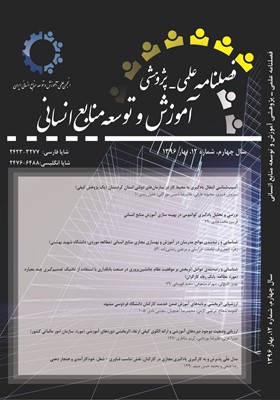ارزیابی وضعیت موجود دورههاي آموزشی و ارائه الگوی کیفی ارتقاء اثربخشی دورههاي آموزشی (مورد: سازمان امور مالیاتی کشور)
محورهای موضوعی :
میترا عزتی
1
![]() ,
علیرضا یوزباشی
2
,
کریم شاطری
3
,
علیرضا یوزباشی
2
,
کریم شاطری
3
1 - دانشگاه تهران
2 - دانشگاه تهران
3 - دانشگاه ایلام
کلید واژه: دوره¬, های آموزشی, اثربخشی آموزشی, سازمان امور مالیاتی, الگوی کیفی,
چکیده مقاله :
پژوهش حاضر، با هدف ارزیابی وضعیت موجود دوره های آموزشی و ارائه الگوی کیفی ارتقاء اثربخشی دوره های آموزشی سازمان امور مالیاتی کشور به روش آمیخته انجام گرفته است. در بخش کمی جامعه آماری شامل کلیه کمک ممیزان، ممیزان و سرممیزان کشور است که به روش نمونه گیری خوشه ای در برخی از استان ها انتخاب شدند. همچنین دوره های آموزشی مالیاتی که طی دو سال اخیر برای کارشناسان اجرا شده است، مورد ارزیابی قرار گرفتند. جهت گردآوری داده ها از پرسشنامه محقق ساخته استفاده شده است. روایی پرسشنامه مورد تائید صاحبنظران آموزشی و پایایی پرسشنامه با استفاده از ضریب آلفای کرونباخ 96/0 گزارش گردید. تحلیل دادهها بیانگر آن بود که وضعیت موجود نیازسنجی دورههای آموزشی، اهداف دورههای آموزشی، محتوای دورههای آموزشی، مدرسان دورههای آموزشی، سازماندهی دورههای آموزشی، ارزشیابی دورههای آموزشی و انگیزش از دید کارشناسان سازمان امور مالیاتی در حد متوسط بوده است. نتایج فوق و انجام مصاحبه با خبرگان مالیاتی، نتایج نشان داد که عمده ترین آسیب های نظام آموزش سازمان امور مالیاتی شامل؛ نیازسنجی (سیستماتیک و علمی نبودن، جامع نبودن، کاربردی نبودن و عدم همکاری پرسنل سازمان در نیازسنجی)، اهداف دوره ها (عدم اطلاعرسانی، کلی بودن و محتوای نامناسب)، آسیب های محتوا (گستردگی سرفصل ها، نبود تیم تدوین محتوا و نظری بودن محتوا)، مدرسان (عدم صلاحیت، پرداخت نامناسب، روش تدریس نامناسب و معیوب بودن سیستم انتخاب مدرسان)، محیط و شرایط برگزاری دوره ها (امکانات و تجهیزات ضعیف و زمان نامناسب برگزاری دورهها)، آسیبهای اجرای دوره ها (عدم تفکیک کارآموزان، عدم حمایت مدیران، زمان اجرای دوره ها و اجرایی نبودن برخی دوره ها)، ارزشیابی آموزشی (پیگیری نکردن اثربخشی آموزش، واقعی نبودن نمرات ارزیابی دوره ها و عدم همکاری سرپرستان در خصوص ارزیابی دوره ها)، انگیزه (نبود مکانیزم های برای تشویق و تنبیه افراد، انگیزه ناکافی کارآموزان و انگیزه ناکافی مدرس ها)، مشکلات فرهنگی (عدم باور سرپرستان به آموزش و نگاه نامناسب مدیران ارشد به آموزش) و نیروی انسانی (کمبود نیروی انسانی و استفاده نادرست از تخصص ها در آموزش) می باشد.
This research tried to assess the situation of training courses and provide a qualitative model for improving the effectiveness of State Tax Organization, using a mixed method approach. First, the current situation of training was investigated and training courses were assessed. In quantitative part, statistical population included all state audit assistants, assistants, and lead auditors who were selected by cluster sampling method in the some provinces as research samples. Regarding intended training courses, it was specified to assess tax-training courses which were held for experts in the last two years. To collect data, a researcher-made questionnaire was used. The validity of questionnaire was confirmed by educational experts and by using Cronbach’s alpha, reliability was reported equal to 0.96. Data analysis indicated that current situation of training courses need-assessment, goals of training courses, content of training course; instructors of training courses, organizing training courses, assessment of training courses, motivation were moderate. Given the above results and interview with tax experts, the results indicated the major training system damages of State Tax Organization included need-assessment (systematic, non-scientific, non-comprehensive, non-functional, and lack of cooperation of staff in need-assessment), goals of courses (lack of information, general, inappropriate content), content damages (the extent of topics, lack of specified team to formulate content, and theoretical content), instructors (incompetence, improper payment, poor teaching method, and faulty system of selecting instructors), environment and condition of holding courses (poor facilities and equipment, and inconvenient time of holding courses), damages of implementing courses (lack of trainees’ separation i.e. co-educational system, lack of managers’ support, time of courses, and non-executive courses), training evaluation (not caring about training effectiveness, unreal assessment scores, and lack of supervisors’ cooperation regarding assessment), motivation (lack of mechanism to encourage and punish trainees, trainees’ insufficient incentive, instructors’ insufficient motivation), cultural problems (supervisors do not believe in training and inappropriate attitude of senior managers to training), manpower(lack of manpower and incorrect use of expertise in training).
